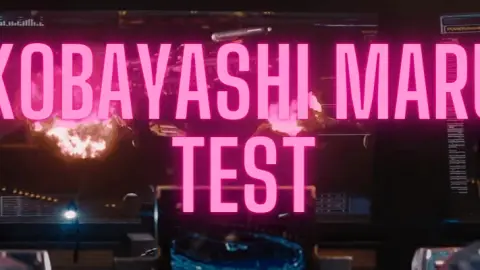In Star Trek II: The Wrath of Khan, Lieutenant Saavik took the Kobayashi Maru test that tested a captain’s ability to face death and fear while still maintaining control. It is a no-win scenario, and every captain that takes the test fails. But James Kirk was the only person who beat the no-win scenario.
James Kirk beat the Kobayashi Maru by reprogramming the conditions of the test. He programmed the test so that when the Klingon battle cruisers attacked his ship, they would recognize his name, stop firing, and help him rescue the ship. No one died, and no interstellar incident happened.
While that answer may seem like the final say in the matter, there is a lot more to the story. Come on in and enjoy the ride!
What Is the Kobayashi Maru?
In the fourth year of Starfleet Academy, all cadets who want to sit in the captain’s chair need to take the Kobayashi Maru test before graduating. It is a simulation with a no-win scenario where a heavily damaged freighter is in the neutral zone near Klingon space and sends out a distress call. But going into the neutral zone is an act of war, and the Klingons attack any ship going into the neutral zone.
As the test progresses, the one taking the test must choose between ignoring the distress call or taking a chance to rescue the freighter survivors. But rescuing the survivors would mean violating several treaties and would risk an interstellar war, as well as risking the ship and their lives.
Every time a cadet tries taking the test, either choice they make results in failing the test and “killing” everyone in the testing room. A cadet could not possibly rescue the survivors, escape the neutral zone, and fight off the Klingons simultaneously, which is why it is a no-win scenario.
Later, after the peace treaty with the Klingons, the test was changed to include the Romulans rather than the Klingons.
No one ever won this test except for James Kirk; later, David Forester and Peter Kirk did the same thing as James did and won the scenario.
What Is the Purpose of the Kobayashi Maru?
Cadets who want to be captains must be prepared for any no-win scenario they encounter during their missions. In a real-life situation, a captain must maintain control over their fears and the fears of their crew and passengers. They also must be ready to face death the same way they face life and come to terms with their ethical boundaries.
It was used to test the character and morals of a cadet to make sure they were suited for the captain’s chair. If they chose to ignore the distress call, they might not make suitable captains.
However, a cadet could argue that they were trying to avoid an interstellar war and obey the treaties. But if they tried rescuing the survivors of the Kobayashi Maru, and everyone died, then they might look favorably to the board because they were willing to go above and beyond to rescue those in need regardless of personal dangers.
No one can know what the test is like until the simulation begins. If they did, they would be able to prepare for the test. In a real-life scenario, they wouldn’t be able to prepare for what comes at them, so the test is there to test what kind of person the cadet is.
Regardless of what choice the cadet made, it would have disastrous consequences for someone. After failing the simulation twice, only one cadet figured a way around this no-win scenario–James Tiberius Kirk.
After James changed the test conditions, he faced a court-martial as it appeared that he cheated. However, he showed that he was willing to do whatever it took to save others, even if it means deception. Because of that point, it was respected because it showed Starfleet potential and values.
How Many Captains Took the Test?
Since the test was a requirement for all who wanted to be captains, almost all captains took the test. Passing or failing the simulation didn’t automatically disqualify a cadet from being a captain. What the cadet faces is the no-win scenario is what passes or fails a cadet for the captain’s chair.
Two captains didn’t take the simulated test, and that was Captain Spock and Leonard McCoy. But at the end of the second Star Trek movie, Spock knew that there was no way out of the situation they were in. After thinking about how James Kirk beat the no-win scenario, Spock took matters into his own hands and saved the ship.
When he was talking with Kirk, he asked, “I’ve never taken the Kobayashi Maru. What do you think of my solution?” Spock sacrificed himself for the good of the ship when it seemed like a no-win scenario.
Lieutenant Saavik tried taking the test, but failed and all but destroyed the simulation room. She was confused about how Kirk beat the test, and when she found out he reprogrammed the test, she thought he cheated.
When Mr. Scott took the test, he used engineering solutions to destroy the waves of Klingon attacks. At the end of the test, to destroy the Klingon ships’ final wave, he used the Parera Field Theory, which was a physical impossibility. However, the computer was satisfied, and he passed the simulation. Once the authorities realized how he beat the no-win scenario, they moved Scotty from command school to engineering school.
Chekov evacuated his crew and rammed his ship into the Klingons, creating a “suicide mission” of sorts. However, this solution did not rescue the crew of Kobayashi Maru and, therefore, was not a viable solution.
After James Kirk reprogrammed the simulation, two other cadets attempted the same thing.
- David Forester–A character in a Star Trek game followed Kirk’s example and reprogrammed the simulation so he could pass. Though it is not clear how he programmed it, it seems that he did the same thing James Kirk did.
- Peter Kirk–James’ nephew, later entered Starfleet Academy and took the Kobayashi Maru test. He challenged the other captain to a duel to the death. While they were fighting, he told the rest of the crew to rescue the freighter ship and warp away. He was the other Kirk to beat the no-win scenario.
When trying for a promotion, Counselor Troi took the simulation test after it was changed to Romulan space. She failed the test several times, then realized that the point was to accept the consequences of a no-win scenario. She was not inventive enough, like Kirk, to reprogram the simulation. However, she more than likely got more out of it and understood what the test tried to teach cadets.
James Failed the Test Twice Before He Passed It
James Kirk took the test three times but failed it the first two times, which didn’t sit too well with him. Failing the test made him realize that he didn’t like to lose and started thinking about changing the test’s conditions. Together with his friend, Ted Horner, changed the conditions of the test.
The simulation was the pivotal point in his life that sent him on the path of being fearless and courageous no matter what the circumstance was.
However, in the Kelvin timeline, Kirk was a rebel and constantly in trouble because his father died while he was a child. He did everything to benefit him, regardless of the consequences. So when he faced a no-win scenario, it would be logical that he would “cheat.”
He Developed the Mindset for Not Losing
After he failed the test a couple of times, Kirk decided that he would not lose ever again, even if he must take matters into his own hands. Whenever he faced situations that looked hopeless or grim, he always looked at them with the idea that there are always possibilities. He thought out of the box and came up with unique solutions.
One of his unique solutions was seen in the movie Star Trek III: The Search for Spock. When they were at the Genesis planet, and the Klingon ship severely disabled the Enterprise, Kirk and his skeleton crew beamed off the ship to the planet below while the Klingons beamed to the Enterprise. Before they left, however, they set it to self-destruct and kill the Klingons.
When on the planet, they watched part of the ship fall into the atmosphere. Kirk said, “My god Bones, what have I done?”
Bones replied in his usual calm and witty manner, “You’ve done what you’ve always done–given us a fighting chance to live.”
Kirk always took charge of a situation and had original thinking throughout his career, making him one of the best captains in the fleet.
James Kirk Programmed His Name as Respectful to Klingons
Before taking the Kobayashi Maru the third time, James Kirk reprogrammed the simulation so that the Klingons would recognize his name when they came to attack the ship. He thought that if the Klingons knew who was coming and that he was only there to rescue a damaged freighter, he could avoid a fight and leave the area without anyone needing to die.
But in real-life scenarios, Kirk’s name was anything but respectful to Klingons. They hated him because of how many times he thwarted their conquests. On the planet where Klingons gave one side weapons without doing the same for the other side. Kirk interfered with their plans by giving the other side weapons, which balanced each side to develop at the same rate.
The Klingons were angry with Kirk because they wanted to claim that planet in the name of the Empire.
They had a deep hatred for him that spanned several decades, and when it came time for the peace talks, they framed him for the murder of Chancellor Gorkon and sentenced him to life on the penal asteroid Rura Penthe.
When Klingon Cruisers Attacked, They Knew His Name
During the simulation, after he reprogrammed the test, he chose to rescue the freighter survivors. Right on cue, the Klingon ships appeared out of nowhere. Before they fired on the ship, Kirk hailed them to identify himself and his mission. They recognized his name and asked if they could offer him and his crew a hand.
In the simulation, he programmed it to contact the lead battle cruiser and talk with the commander. When the Klingons heard his name, they believed that he was a legendary hero. Kozor let them go and escorted them to the freighter.
Ironically, later in his career, the Klingons knew his name alright, but not in the way they did in the simulation. He was known as a renegade, a dictator, and a murderer to the Klingon Empire.
Kirk Rescued the Kobayashi Maru With the Help of Klingons
The Klingons helped Kirk rescue the Kobayashi Maru and prevented other Klingons from firing on them during the rescue. Because Kirk programmed the simulation where it was possible to win, he avoided facing death head-on. He didn’t like losing and refused to lose.
They only helped him because they thought he was a legendary hero, which was the reprogramming topic.
His superiors were angry and almost kicked him out of the Academy, with 99 demerits. After all of the criticism, he was given a commendation for original thinking, and he became the youngest Starfleet ever to become a captain of a starship.
An Interstellar Incident Was Avoided
Since the Klingons assisted Kirk to rescue the survivors, an interstellar incident was avoided, and any war that could have happened didn’t because of how the simulation was programmed.
During many of the real missions that the Enterprise encountered, Kirk had much of the same mentality. When they encountered the Romulans for the first time in a century, they managed to escape unharmed due to Kirk’s unique fighting style. Spock assisted in many of Kirk’s solutions by adding the scientific element needed to get out of tricky situations. Together, they avoided many interstellar wars.
Kirk’s answer to the simulation mirrors many of his adventures in the series and the movies. When faced with unwinnable situations, he thought outside of the box and saved everyone.
The Klingons Respected James T. Kirk in the Simulation
In the simulation, the Klingons respected James T. Kirk because they thought he was a hero and helped rescue the freighter’s crew. Once he got past the Klingon patrol, he warped away, giving him time to rescue the crew.
But in the Star Trek universe, the Klingons despised Captain Kirk so much that they often sought him to kill him. In “The Trouble With Tribbles,” Kirk was instantly despised and distrusted, even as he investigated the grain issues. It turned out that the Klingons poisoned the grain to conquer the planet it was going to. Scotty transported the tribbles to the Klingon ship, which made them respect Kirk even less.
Another instance that angered the Klingons was in the episode “A Private Little War,” where they gave weapons to one group of people on a pre-warp planet but not the other group. Kirk balanced the war by giving the other group the same weapons, which the Klingons got angry about.
The Alternate Kirk Inserted a Subroutine and a Virus Into the Simulation
An alternate James Kirk from the Kelvin timeline actually did cheat in this simulation by installing different subroutines to the test. During this alternative timeline, Kirk made it possible to lower the Klingons’ shields and destroy them with one torpedo strike. The way he won this scenario was unacceptable to the top brass and was brought up on disciplinary charges.
During the hearing, there was a distress call from Vulcan. Nero, from the Prime timeline, was attacking the planet. Starfleet sent the Enterprise with Kirk on board to save the planet. Once it was done, the academic council dismissed charges and got a commendation for original thinking.
A deleted scene from one of the Kelvin timeline movies showed that Kirk was dating Uhura’s roommate simply because she was a technician. He wanted access to the simulator so he could place different subroutines in the test. He emailed her during the simulation that implanted a virus in the simulation, which made it possible for him to reprogram the test and beat the no-win scenario.
Conclusion
Regardless of the timeline, James Kirk was a renegade thinker with unique solutions to problems that would make most people run the opposite direction. He never liked losing any scenario, but he was afraid of death.
When Spock died in the second Star Trek movie, he had a very difficult time accepting that one of his best friends sacrificed himself for the ship’s good. His son David reminded him that “how we face death is at least as important in how we face death.” Kirk finally realized that death is a part of life, and when situations require a life or death scenario, it’s okay to lose for the greater good.
Sources
- Forbes: The Philosophy of Star Trek: Kobayashi Maru, No-Win Scenarios, and Ethical Leadership
- Wikipedia: Kobayashi Maru
- Wikipedia: The Kobayashi Maru (Star Trek Novel)
- Birth Movies Death: James T. Kirk Did Not Cheat On the Kobayashi Maru Test
- Memory Alpha: Kobayashi Maru Scenario
- Memory Beta: James T. Kirk
- Memory Beta: Kobayashi Maru Scenario
- Memory Beta: Peter Kirk
- Memory Beta: David Forester




